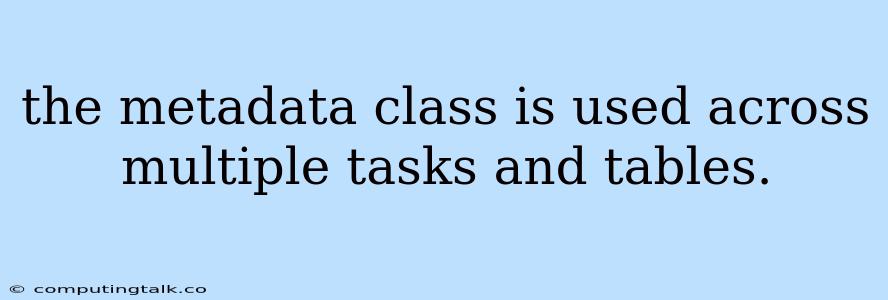The concept of a metadata class is a powerful tool in software development, especially when dealing with large datasets and diverse applications. Its ability to be used across multiple tasks and tables offers a streamlined and efficient approach to managing data. Let's explore how and why this approach is so valuable.
What is a Metadata Class?
A metadata class essentially acts as a blueprint or definition for your data. It defines the structure, properties, and relationships of the data you are working with. Imagine it like a template for your data, ensuring consistency and clarity across different parts of your project.
Why Use a Metadata Class Across Multiple Tasks and Tables?
1. Consistency and Standardization:
- A single source of truth: By defining your data structure in a dedicated metadata class, you create a central point of reference. This ensures that all your tasks and tables use the same definitions, eliminating inconsistencies and potential errors.
- Reduced maintenance: When you need to make changes to your data structure, you only need to modify the metadata class. This single change will automatically propagate across all tasks and tables that utilize it, saving you time and effort.
2. Enhanced Reusability:
- Shared components: The metadata class acts as a reusable component that can be shared across multiple tasks and tables. This reduces code duplication, improves maintainability, and promotes code organization.
- Modularity: Since the metadata is separated from the actual data, you can easily adapt your application to handle different data sources or formats without significant code changes.
3. Improved Flexibility:
- Data independence: The separation of data structure from data itself allows for greater flexibility. You can modify your data structures or even use different data sources without impacting the logic that depends on the metadata class.
- Dynamic data handling: Metadata classes can be used to dynamically handle data based on the specific needs of each task or table. This provides greater control and allows you to tailor your applications to various scenarios.
Practical Example: A Blog Application
Let's imagine you're building a blog application. You might use a metadata class to define the structure of your blog posts:
class BlogPostMetadata:
title: str
author: str
date_published: datetime
categories: list[str]
content: str
Now, this metadata class can be used across multiple tasks and tables:
- Adding a new post: When creating a new post, the data entered must conform to the structure defined in the
BlogPostMetadataclass. This ensures consistency in your data. - Listing posts by category: You can easily filter and retrieve blog posts based on the
categoriesattribute defined in the metadata class. - Displaying a single post: The
BlogPostMetadataclass provides the blueprint for how each blog post should be displayed, ensuring consistent presentation across your blog.
Conclusion
The metadata class is a powerful tool that promotes code organization, reduces redundancy, and enhances the flexibility of your software applications. By using a dedicated metadata class across multiple tasks and tables, you can ensure data consistency, improve reusability, and simplify your development process.
